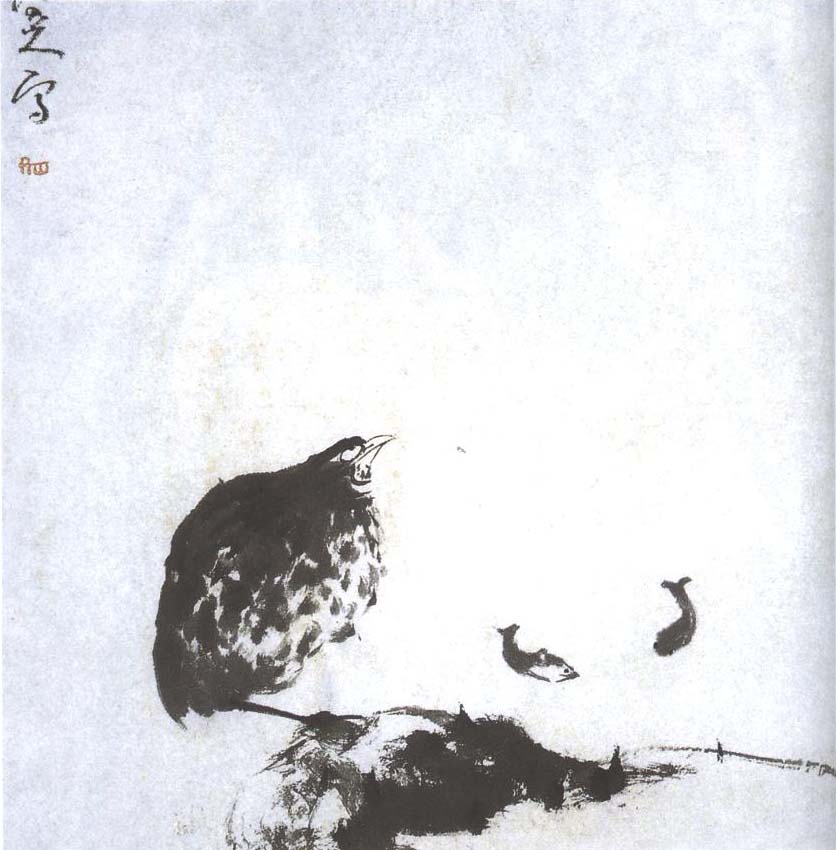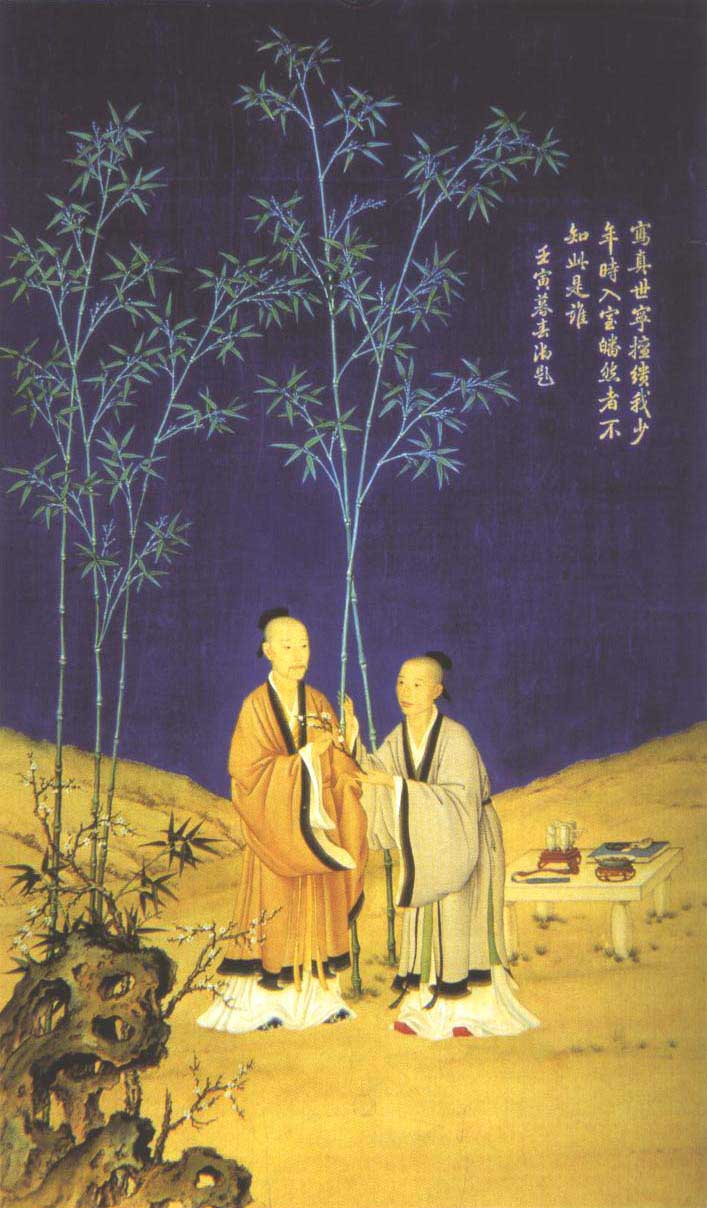|
| |

|

VIII.
Qing Dynasty
In 1644, the Manchu people entered Shanhaiguan Pass. The arrogant Manchus in this year would never expect that they will become the last rulers of China's dynastic cycle. For this ethnic group who was used to military life, the China they took over was more like a hot potato than when it was in Mongols' hands. On one hand, there were many disgruntled adherents of the Ming Dynasty; on the other hand, the industrial revolution which took place in Britain in the eighteenth century had rapidly spread over Europe and the United States, and its chilly corner would push China into a position that she never foresaw.
The most prominent artist among court painters in the Qing Dynasty was Giuseppe Castiglione. Castiglione (Chinese name Lang Shining), was an Italian missionary who came to China in 1915. As a skillful artist, Castiglione was called into the palace by the Emperor Kangxi, an emperor who attached great importance to the Western technology, and served as a court painter from then on for more than five decades. Through diligent working, Castiglione mastered the academic style that his colleagues were proficient at; in the meantime, he added the Western perspective skill as well as coloring method into the works created from brush, Chinese colloid pigments, rice paper and silk, forming an eclectic style that blended the European and Chinese techniques. |
|

|
From the reign of Emperor Kangxi to Emperor Qianlong, Castiglione was extremely appreciated in the palace, since his heavy-colored realistic style was suited for the decoration demand there very well. The other court painters in the Qing Dynasty, such as Jiao Bingzhen, Leng Mei, and Ding Guanpeng, also started to adopt the western way to paint under his influence. Except for Castiglione, the Western missionary and painter who came to China in the same period included Jean Denis Attiret (Chinese name Wang Zhicheng) from France, Ignace Sichelbarth (Chinese name Ai Qimeng) from Bohemia, and Louis Antoine de Poirot (Chinese name He Qingtai) from France. Although their works were criticized as "without brushstrokes, with neatness that belongs to artisan, they should not be counted into the qualified paintings", these painters still cannot be ignored in the Chinese art history. As early as in the end of the Ming Dynasty, the western influence on Chinese painting had been on the horizon. Castiglione and his followers in the Qing court could accurately depicted the object's appearance, while correspondingly, at the cost of the loss of spirit and artistic conception which is dominant for traditional Chinese painting. Therefore some scholars and painters rejected to accept Castiglione, considering what he painted was not Chinese painting.
|
|
Other than the impact from the West in the imperial painting academy, the literati painting was still the mainstream in the Chinese art world, and was still appreciated by the emperor and the upper class. In the early Qing Dynasty, referred as the "Four Wangs", Wang Shimin, Wang Jian, Wang Hui, and Wang Yuanqi, sometimes with Wu Li and Hui Shouping referred as "Four Wangs and Wu and Hui" or "Six Masters in the early Qing", were representative orthodox landscape painters in this period. Without significant innovation, their landscape painting was inherited from Dong Qichang and kept on good terms with the past, nevertheless, the authentic tradition of literati painting which they represented still has merit.
When literati painting developed into the Qing Dynasty, it gradually lost its significance of rebellion and renovation, and had become another kind of academic for its conventionalization and repetitiveness. However, it doesn't mean that all literati painters would like to follow the beaten track. The most creative literati painters came from the adherents of the Ming Dynasty, who could generate a pure power in their paintings from the anger and pity for a defeated country and a lost home. Monk Hong Ren is the founder and most outstanding painter of the Anhui school of landscape painting. He loved to paint the Yellow Mountain (Mt. Huangshan), but the pine on cliff he painted is often inverted, bringing viewers a sense of alienation and loneliness. Being influenced by Ni Zan, however, Hong Ren clearly showed more personal feelings in his paintings than just imitating the nature. Of course his expression is a traditional literati type, by changing all his anguish and sorrow into an inverted Huangshan pine. The Nanjing painter Gong Xian's landscape expresses another kind of lonely. Gong was good at using ink, as well as developed the accumulated ink method initiated by predecessors. If the landscape paintings created by masters in the Song Dynasty are noted for the "transparency", landscapes by Gong Xian, on the contrary, is famous for its "untransparency". In his painting there are airtight landscapes, despair that nowhere to hide from, and dead silence. Not all adherent painters of the Ming Dynasty are as cold as Gong Xian. Kun Can, courtesy name Shi Xi (means stony brook), became a monk after the fall of Ming Dynasty. His style of landscape painting was influenced by Wang Meng, but is more complex and full of countless details that fill the picture, expressing a feeling of broad-minded and tolerant. The personality that Kun Can showed in his landscape painting is quite a warm one. |
|
In the early Qing Dynasty, there were four outstanding painters as well as adherents of the Ming Dynasty and monks, who are called the "Four Monk Masters" by later generations. Hong Ren and Kun Can are two of them, and the other two are Bada Shanren and Shi Tao. In fact, the latter two monks really accomplished an epoch-making achievement in the Chinese art history. Bada Shanren, whose original name is Zhu Da, was a descendent of the royal family of the Ming Dynasty. After the Qing Dynasty established, he shaved his head to be a Buddhism monk. For the Sutra of Eightfold Enlightenment (Ba Da Ren Jue Jing in Chinese pinyin) he used to exercised, he named himself Bada Shanren. |

|
|
The stylized vertical writing of his pseudonym Bada Shanren on his paintings is quite unique, when Bada looks like the characters for laugh and Shanren looks like cry, thus by signing his paintings he implied his confusion and feelings of grief for the fate of his country and home. Bada Shanren's painting style was born out of Xu Wei's in the Ming Dynasty, but more incisive and cynic. He has an extreme inner world, while his painting expressed an extreme world as well. The bird, fish, duck he depicted are all lonely and angry, who often roll their eyes heavenward on a endless blank background; the wood, stone, mountain and water he depicted are nothing near comfortable, expressing a feeling of desolated and incomplete. After the Manchu took over the throne, Zhu Da decided not to speak anymore. Some said he was crazy, and some said he was pretending to be crazy. Every time he went into the street, he was followed by a group of children who made fun of him behind. This is a bit like his Western peer Van Gogh. However, his expression method is extremely oriental, like Zen painting, with simple and unconstrained brushstrokes. Bada Shanren is a betrayer of the tradition, as well as an innovator of the tradition. Being different from the previous innovators, Bada's style is impossible to imitate. His seemingly simple composition and seemingly casual brushstrokes are all rooted in his own temperament; the artist conveys his energy to the viewers in a special confirmed and confident way; therefore, his style cannot become a paradigm, and makes anyone who tries to imitate him shrink back. Comparing with Bada Shanre, whose style is simple, straightforward, but with strong visual impact, Shi Tao, the other descendent of the imperial clan of Ming Dynasty, was more mellow and rational. Shi Tao, original name Zhu Ruoji, was only three years old when the Ming Dynasty collapsed. During his young age, his family had gone downhill and he became a Buddhist monk afterwards. Shi Tao's aesthetic thoughts were recorded in his theory book "Painting Quotations". He advocated a painting theory of "heaven and man united as one", just as what he practiced in his own paintings. For example, the title of one of his paintings "Search Every Lofty Peaks for A Draft" itself is an argument. Shi Tao's style is very lively and colorful by using all kinds of ink including dry, wet, heavy and light. The brushstroke he used to paint mountains is quite unique, which is, before one line was finished, a new direction was born from the old direction, thus every line is twisted and turned, and the charm of stroke is inexhaustible. Shi Tao doesn't agree to imitate the ancient style, while his freedom in brushstrokes can be described in his own words, "even the brushstroke is not like brushstroke, or the ink is not like ink, there is an I in it." Shi Tao loved social life, and in the meantime, he could consciously keep an expressive force in his painting. His style encouraged many excellent individualistic painters in the eighteenth century, who were often called "Eight Eccentrics of Yangzhou".
|
|

|
Beijing referred as the Eight Eccentrics of Yangzhou, they were not eight people, but a group of professional painters, including Zheng Xie, Li Shan, Li Fangying, Jin Nong, Gao Xiang, Wang Shishen, Huang Shen, Luo pin, Hua Yan and so on, who arose in the affluent Yangzhou in the middle of eighteenth century. Their eccentric and stylized style were often deemed anti-tradition by their contemporaries; however, unlike their predecessors Zhu Da and Shi Tao, the eccentric artistic style in their paintings was not from heavy historical burden or anger toward reality, but more from a purely playful attitude. The seriousness which could usually be found in the adherent painters in the early Qing Dynasty had disappeared here. In the mid eighteenth century, a lot of salt merchants in Yangzhou had just ascended into the gentry class, therefore they were badly in need of art to put on the dog. In order to get the salt merchants' attention, the large number of professional painters in Yangzhou had to run after the novelty and thus, their anti-tradition and non-mainstream were more or less artificial. In the past, most of literati paintings were painted as a hobby by wealthy scholars, so there was no fierce competition. Alone with urbanization and commercialization, the market gradually grew into a new force which could influence the painting style.
|
| Painting of the late Qing Dynasty was less innovative than the previous dynasties, while even showed signs of imitation, but it was not without success. In the first half of twentieth century, numerous artists gathered in the metropolitan area of Beijing, Shanghai, and Guangdong, therefore the Beijing School, Shanghai School, and Lingnan School came into being respectively. By the end of the Qing Dynasty, the commercial city Shanghai attracted a group of professional painters, such as Zhao Zhiqian, Ren Xiong, Ren Xun, Ren Yi, Wu Changshuo, etc., who lived by selling paintings. They were creative in both style and technique to meet the needs of the public, who were called "Shanghai School". In the Lingnan area, Ju Lian, Ju Chao became pioneers of the Lingnan School. |
清朝
1644年,满族人入关。在这一年志得意满的满族人应当没有料到,他们即将成为中国王朝循环模式中的最后一位掌权者。对于这又一个习惯了戎马生涯的民族来说,他们接手的中国比昔日蒙古人接手的更像一个烫手的山芋。一方面,中国国内还存在许多心怀不满的明朝遗民汉人志士,另一方面,十八世纪开始在英国发生的产业革命迅速席卷欧美,其料峭的边角把惘然无知的中国扫入到一个她不曾料到的位置。
在清朝宫廷画家中,地位最显赫的是郎世宁。郎世宁,意大利人,原名朱塞佩·伽斯蒂里奥尼(Giuseppe Castiglione),1915年以传教士身份来到中国。当时郎世宁已是一位画艺精湛的画家,重视西方技艺的康熙将之召入宫中,从此开始了他长达五十多年的宫廷画家生涯。郎世宁工作勤勉,很快掌握了中国同行们的学院派风格,并将西方透视法以及色彩运用融入到以毛笔、胶质颜料、纸绢创作的作品中,形成一种融合了中西方技法的折中风格。从康熙到乾隆时期,郎世宁在宫中极受欢迎,他浓艳的写实主义风格非常适合宫廷的装饰。受他的影响,清宫廷画家如焦秉贞、冷枚、丁观鹏等也开始用西法作画。同一时期来华的西洋传教士兼画家还包括法国的王致诚、波希米亚的艾启蒙、法国的贺清泰等,他们的作品虽被评论为“笔法全无,虽工亦匠,故不入画品”,但他们仍是中国绘画史中不可忽略的人物。中国画受西方的影响早在明末人物肖像画中已初见端倪,发展到清朝宫廷,从郎世宁和其追随者的画风看来,他们对绘画对象的“形”的把握更为精确,然而与之相应,付出的代价则是中国传统绘画中居于主导地位的神韵和意境的丧失。因此有部分学者和画家排斥郎世宁,认为他所画的并非中国画。
在宫廷画院里西风东渐的同时,整个中国画坛中文人画仍然是中国画的主流,皇帝和上流社会依然赏识这种传统的方式。清初山水画家中较为著名的有四位姓王的画家,他们是王时敏、王鉴、王翚、王原祁,统称“四王”,有时也加上吴历、恽寿平二人,合称“四王吴恽”或“清初六家”,这些人是清初山水画的代表。他们的山水画继承董其昌的余绪,与传统一团和气,虽未有显著创新,但他们所代表的正宗文人画传统仍有可称道之处。
文人画发展到清朝,渐渐已失去了早期反叛与追求变革的意味,其程式化与重复性使之成为另一种意义上的学院派。但这并不代表所有文人画家都甘愿落此巢臼,最具创造性的文人画家来自于明朝遗民阶层,国破家亡的愤懑在他们的画中形成一股纯粹的力量。安徽的僧人弘仁是徽派山水画的创始人和最杰出者,他爱画黄山,笔下山崖边的松树往往是倒错着生长,给人空廖疏离之感。弘仁的画风受倪瓒影响,然而与师法自然相比,他的画面上却更明显地流露出画家本人的意志,当然他的表达方式是中国传统的文人式的,满心苦闷和家国之忧化作倒着生长的黄山松。南京画家龚贤的山水是另一种寂寥。他善于用墨,发展了前人的积墨法。如果说宋代大家们的山水以“透”为长,龚贤山水的特点恰恰相反,在于不透。密不透风的山水,无处躲藏的绝望,死气沉沉的寂静。并非所有的遗民画家的画风都如此冷峭。髡残,号石溪,明亡后落发为僧。他的画风受王蒙影响,而更为繁繁复复,跌跌撞撞,无数细节充盈着画面,有博大而宽容之感。从他的山水看来,髡残本人应当是个拥有温暖性格的人。
清初有四位杰出的明代遗民画家,同时也都是僧人,上面所提弘仁、髡残,再加上八大山人、石涛二人,后人称之为“四僧”。实际上,后面两位僧的绘画成就才真正起到了划时代的作用。八大山人,原名朱耷,是明代皇室的远房后裔,入清以后削发为僧,因曾经持有八大人觉经,所以自称八大山人。八大山人在书画上的署名非常独特,竖排文字中,“八大”二字连起来看像哭字,“山人”二字连起来看像笑字,四字并列,即哭之笑之,抒发了画家对亡国亡家的愤懑抑郁之情。八大山人的画脱胎于明代的徐渭等人,然更淋漓尽致、愤世嫉俗。他拥有一个极端的精神世界,他的画描绘的也是一个极端的世界。他笔下的鸟、鱼、鸭,无不显得孤独而愤怒,常常瞪着白眼朝天而望,背景是无尽的空白;他笔下的木石山水,无不佶屈聱牙,有残山剩水,地寒天荒之意境。满人夺取皇位之后,朱耷决心不再说话,有人说他疯了,有人说他是佯疯,每次他上街,身后都跟着一群取笑他的儿童。这种情状有点像他西方的同行梵高,可他的表现方式是极其东方的,有禅宗画的意味,表现在笔墨上就是极尽简洁而无羁。八大山人是传统的离经叛道者,也是传统的创新者。与前辈创新者们不同,八大的风格难以模仿,他的画面看似简单,笔法看似随意,实际上一笔一划都浸透了他个人的性情,他的笔触之中充满笃定和自信,将画家的能量传达给观者,因而他的画风成为不了一种范式,也让试图模仿者望而却步。与简单直接却极具视觉冲击力的八大山人比起来,另一位明朝宗室后裔石涛要圆润理性得多。石涛俗家名朱若极,明亡时他年仅三岁,少年时家道中落,出家为僧。石涛的美学思想集中在他的画论《画语录》中,他主张天人合一的“一画”法,他本人的绘画也实践了这个理论,如《搜尽奇峰打草稿图》,画名本身就是一个立论。石涛的画风十分轻快,形式色彩鲜艳活泼,枯湿浓淡墨兼施并用,他画山用的笔法更是非常独特,常常一笔未到老又生新路,因此笔笔曲折,笔意无穷无尽。石涛并不提倡摹古,他用笔用墨的自由用他自己的话来说就是:“纵使笔不笔,墨不墨,自有我在。”石涛爱好交际,同时也能在画中清醒地保持自己的表现力。他的风格鼓励了18世纪许多优秀的个人主义画家,这些人通常被称为“扬州八怪”。
扬州八怪并不是八个人,而是指十八世纪中期在经济富庶的扬州出现的一批职业画家,包括郑燮、李鱓、李方膺、金农、高翔、汪士慎、黄慎、罗聘、华嵒等人。他们的画风怪异,各有特色,被时人认为是狂放的反传统派。然而与他们的前辈朱耷、石涛等人不同,他们的怪异并非出自沉重的历史负担和对现实的愤懑,而更多是出自一种纯粹戏谑的态度,明末清初遗民画家的严肃感在扬州八怪这里消失了。十八世纪中期,扬州诸多盐商刚刚跻身为新兴的士绅,急需艺术来装点门面。扬州的职业画家群人数庞大,画家们为吸引盐商注意而不得不求新求异,他们的反传统和非主流难免有人工编排的因素。过去的文人画大都是有产有业者的业余嗜好,不存在激烈的竞争,随着城市化和商业化的发展,市场逐渐成为左右绘画风格的新势力。
晚清的绘画虽然与之前的朝代比较,少有伟大的创举,甚至有因袭模仿的嫌疑,但也并非全无建树。20世纪上半叶,中国画家广泛分布于北京、上海、广东地区,分别形成了海派、京派、岭南派,清末,商业重镇上海吸引了一批职业画家,如赵之谦、任熊、任薰、任颐、吴昌硕等人,他们靠卖画为生,风格技巧都有所创新,适应当时市民阶层的需要,这些人被称为“海上画派”。而岭南地区的居廉、居巢则成为开创岭南画派的先驱。 |
|
|
|
|
|
|
| <-
Previous Page |
|
|
|
|
|